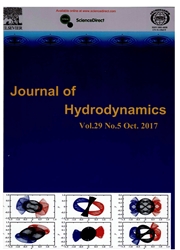

 中文摘要:
中文摘要:
With the rapid development of high dam projects within China, the dragon-drop-tail spillway tunnel is introduced and widely used. In view of the high water head and the large flow velocity on the dragon-drop-tail section, aerator devices are usually placed for the cavitation damage control. For the device placed in its initial position, it is a serious concern to design a suitable flow regime of the cavity and to control the cavity filling water due to the large flow depth and the low Froude number through this aerator. In this study, the relationships between the geometries of the aerator device and the jet impact angle of the lower trajectory of the flow are theoretically analyzed with/without a local slope. Nine test cases with different geometries are designed, the effectiveness of the filling water control is experimentally investigated under different operation conditions, and two criteria of the local slope design are proposed. It is concluded that the cavity flow regime and the filling water can be improved if a small impact angle and some suitable geometries of the local slope are designed.
 英文摘要:
英文摘要:
With the rapid development of high dam projects within China, the dragon-drop-tail spillway tunnel is introduced and widely used. In view of the high water head and the large flow velocity on the dragon-drop-tail section, aerator devices are usually placed for the cavitation damage control. For the device placed in its initial position, it is a serious concern to design a suitable flow regime of the cavity and to control the cavity filling water due to the large flow depth and the low Froude number through this aerator. In this study, the relationships between the geometries of the aerator device and the jet impact angle of the lower trajectory of the flow are theoretically analyzed with/without a local slope. Nine test cases with different geometries are designed, the effectiveness of the filling water control is experimentally investigated under different operation conditions, and two criteria of the local slope design are proposed. It is concluded that the cavity flow regime and the filling water can be improved if a small impact angle and some suitable geometries of the local slope are designed.
 同期刊论文项目
同期刊论文项目
 同项目期刊论文
同项目期刊论文
 Experimental study of the interaction between the spark-induced cavitation bubble and the air bubble
Experimental study of the interaction between the spark-induced cavitation bubble and the air bubble 期刊信息
期刊信息
